Dial Plan Models¶
Overview¶
From the Dial Plan Models menu, a sub-menu and base model called Dial Plan Model is available to define the dial plan and to enter a name and type to group its elements.
The Dial Plan Type drop-down is used to tag it with its hierarchy, so that available dial plans to push or remove are filtered when using the Dial Plan Maintenance menu:
- Multi-tenant / Shared Architecture - provider hierarchy
- Global - customer hierarchy
- Site - site hierarchy
Note
If no Dial Plan Type tag is added to a dial plan, a new “in-progress” or “staging” dial plan can be created that will not show up to be pushed or removed on the Dial Plan Maintenance menu.
A description and notes for the Dial Plan Model definition can be added on the input form.
Dial Plan Model Elements¶
The remaining list of menus manage elements of dial plans created with the feature. Individual elements such as Route Patterns, SIP Trunks, and Translation Patterns each have a menu item from which it can be associated with a Dial Plan Model and managed.
The feature provides menu items or input fields to extend schema based dial plan management functionality. When a dial plan created with the feature is pushed from the Dial Plan Maintenance menu, the transaction log can be inspected to see the extended functionality:
- Device Pools - Regions - Locations -SRST
- Transcoders
- Conference Bridge
- Media Resource Groups
- Media Resource Group Lists
- Route Groups
- SIP Trunks
- CTI Route Points with Lines (Lines are not supported in schemas)
When managing these dial plan elements, the installed named macros can be used to refer to data added from the Dial Plan Input Data menu.

The list view from each of these menus shows the Dial Plan Name - as defined from the Dial Plan Model menu - to which the element belongs. The feature structures the elements as instances of distinct data models.
There is an additional flexibility in the Route Patterns and Translation Patterns dial plan model elements so that a Local Dialing check box can be selected here if required when using a simpler or flat dial plan.
Dial Plan elements, such as Calling Search Space, can be cloned and edited to easily add another element to the dial plan by defining an “add-on” dial plan model, associating the cloned CSS element with it and pushing it to the required Call Manager cluster using the Dial Plan Maintenance menu. In this way the dial plan can be then be updated - functionality that is not possible in a schema based approach.
Additional workflows in the feature allow for values (for example MRGL) to be added from for example the Device Pools - Regions - Locations -SRST element input form, since the workflow will push to the these to the Call Manager cluster only after the prerequisite values become available. Inspect the transaction log to see the required sequence of data carried out with these workflows.
Device Pools - Regions - Locations - SRST¶
The Device Pool, Region, Location and SRST Reference dial plan model have been combined into one coherent data model for ease of entry into a call manager since the elements are often related.
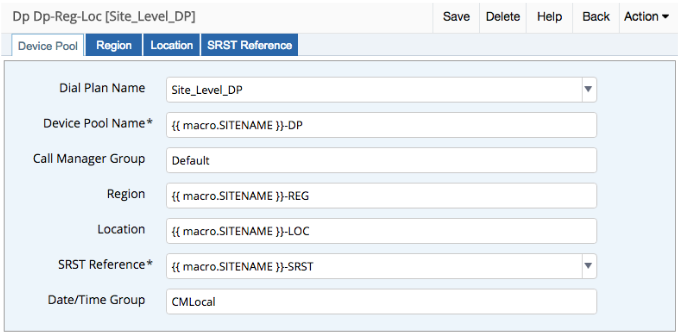
- Device Pool tab fields:
- Dial Plan Name: Drop-down driven unique name given to the entire dial plan as a whole. This name appears in every dial plan model type.
- Device Pool Name: Free text field to add a device pool name or macro.
In this example the name is built using a macro reference and a static extension of
-DP. - Call Manager Group: Free text field to add a call manager group name.
- Region: Free text field to enter a call manager existing region to the device pool or the field will automatically update with the name of the custom added region from the Region tab.
- Location: Free text field to enter a call manager existing location to the device pool or the field will automatically update with the name of the custom added location from the Location tab.
- SRST Reference: Free text field to enter a call manager existing SRST reference to the device pool or the field will automatically update with the name of the custom added SRST reference from the SRST Reference tab.
- Date/Time Group: Free text field to add a date time group name.
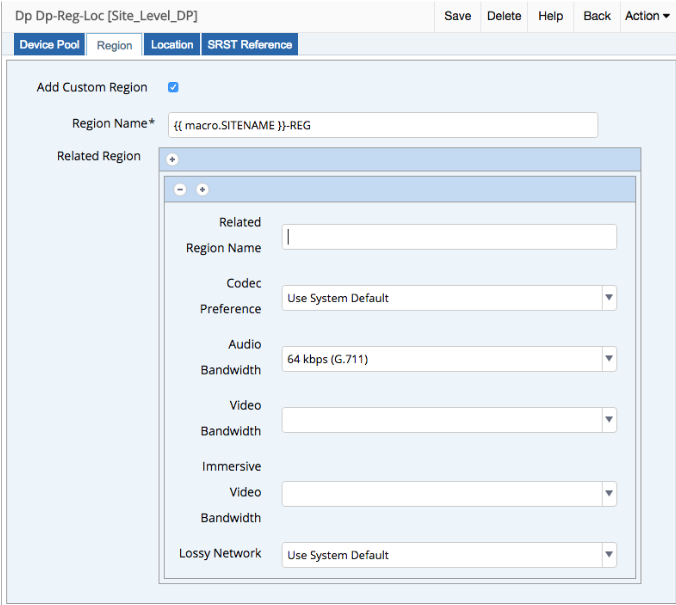
- Region tab fields:
- Add Custom Region: Check box to optionally add a custom region.
- Region Name: Free text field to add a region name. In this example
the name is built using a macro reference and a static extension of
-REG. - Related Region: Ability to add related regions to the custom region.
- Related Region Name: Free text field to add a related region.
- Codec Preference: Drop-down with choices:
- Use System Default
- Factory Default lossy
- Factory Default low loss
- Audio Bandwidth: Drop-down with choices:
- Use System Default
- 7 kbps (GSM-HR, G.723.1)
- 8 kbps (G.729)
- 13 kbps (GSM-FR, AMR)
- 16 kbps (iLBC, G.728)
- 24 kbps (AMR-WB)
- 32 kbps (iSAC, G.722.1)
- 64 kbps (G.711)
- 128 kbps (AAC-LD [LATM])
- 256 kbps (L16, AAC-LD)
- Video Bandwidth: Drop-down to choose video bandwidth setting with choices:
- Use System Default
- Not Allowed
- Immersive Video Bandwidth: Drop-down to choose immersive video bandwidth
with choices:
- Use System Default
- Not Allowed
- Lossy Network: Drop-down to choose lossy network setting with choices:
- Use System Default
- Keep Current Setting
- Low Loss
- Lossy

- Location tab fields:
- Add Location: Check box to optionally add a custom Location.
- Location Name: Free text field to add a location name. In this example
the name is built using a macro reference and a static extension of
-LOC. - Within Audio Bandwidth
- Within Video Bandwidth
- Within Immersive Kbits
- Between Location group of fields:
- Location Name
- Audio Bandwidth
- Video Bandwidth
- Immersive Bandwidth
- Weight
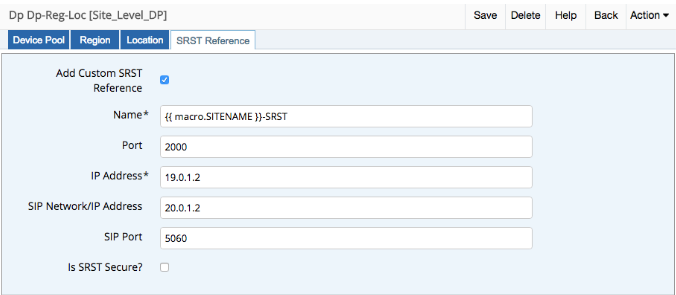
- SRST Reference tab fields:
- Add SRST Reference: Check box to optionally add a custom SRST Reference.
- SRST Reference Name: Free text field to add a SRST Reference name.
In this example the name is built using a macro reference and a static extension
of
-SRST. - Port
- IP Address
- SIP Network/IP Address
- SIP Port
- SRST Secure?
Time Period Model¶
This allows the administrator to define an unlimited number of time periods.
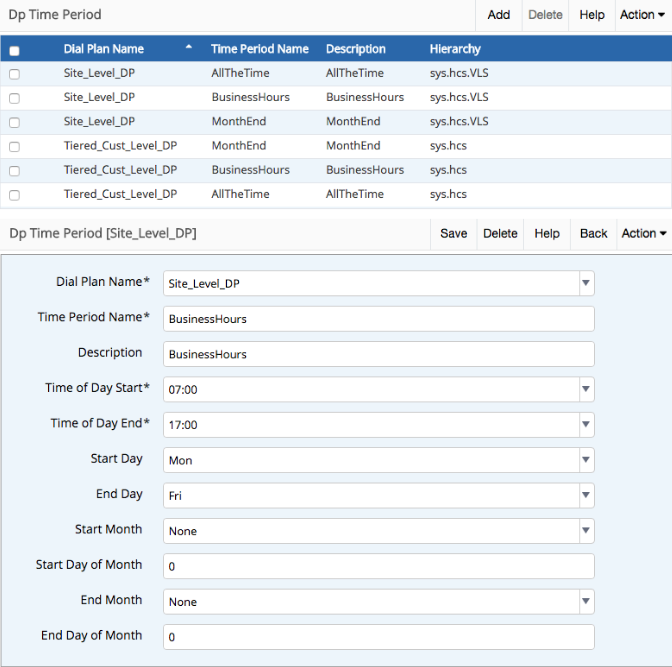
Time Period fields:
- Dial Plan Name: Drop-down driven unique name given to the entire dial plan as a whole. This name appears in every dial plan model type.
- Time Period Name: The free text name for desired time period.
- Description: Meaningful description of the time period.
- Time of Day Start: Drop-down driven field to set start of time period in 15 minute increments.
- Time of Day End: Drop-down driven field to set end of time period in 15 minute increments.
- Start Day: Drop-down driven field to set start day giving “Mon”-“Fri” and “None” as options.
- End Day: Drop-down driven field to set end day giving “Mon”-“Fri” and “None” as options.
- Start Month: Drop-down driven field to set start month giving “Jan”-“Dec” and “None” as options.
- Start Month: Drop-down driven field to set start month giving “Jan”-“Dec” and “None” as options.
- Start Day of Month: Free text field to add integer of start day of the month
- End Month: Drop-down driven field to set end month giving “Jan”-“Dec” and “None” as options.
- End Day of Month: Free text field to add integer of start day of the month.
Time Schedule Model¶
This allows the administrator to define an unlimited number of time schedules.
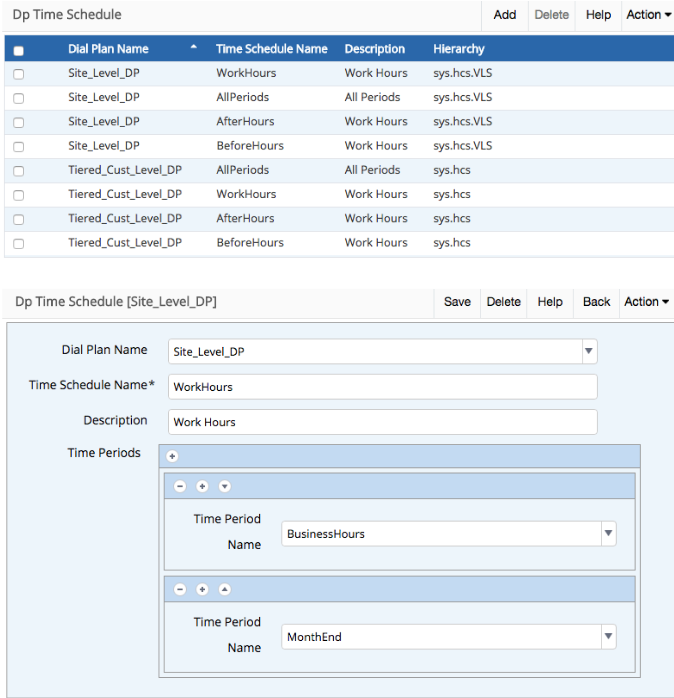
Time Schedule fields:
- Dial Plan Name: Drop-down driven unique name given to the entire dial plan as a whole. This name appears in every dial plan model type.
- Time Schedule Name: Free text field to enter a unique time schedule name.
- Description: Meaningful description of the time schedule.
- Time Periods: An array of time periods that provides drop-downs of time periods defined from the Time Period.
Transcoder Model¶
The transcoder dial plan model allows the administrator to define an unlimited number of transcoders.
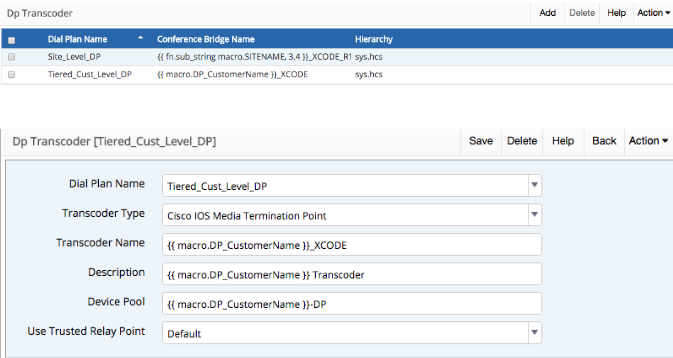
Transcoder fields:
- Dial Plan Name: Drop-down driven unique name given to the entire dial plan as a whole. This name appears in every dial plan model type
- Transcoder Type: Drop-down field to set Transcoder Type. Currently only supports Cisco IOS Media Termination Point but will be expanded based on market input.
- Transcoder Name: Free Text field where a unique name should be entered. In
the above example the macro will fill the VOSS customer name with
_XCODEsuffix. - Description: Meaningful description of the transcoder
- Device Pool: Free text field to identify the proper device pool.
- Use Trusted Relay Point: Drop-down with values:
- Default
- Off
- On
Conference Bridge Model¶
The Conference Bridge dial plan model allows the administrator to define an unlimited number of Conference Bridges.
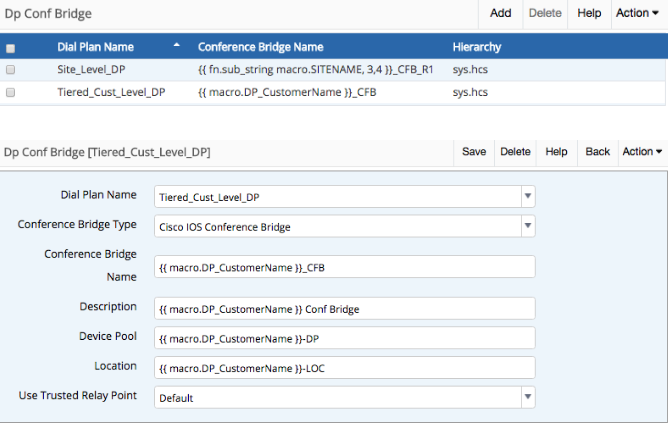
Conference Bridge fields:
- Dial Plan Name: Drop-down driven unique name given to the entire dial plan as a whole. This name appears in every dial plan model type.
- Conference Bridge Type: Drop-down field to set Transcoder Type. Currently only supports Cisco IOS Conference Bridge but will be expanded based on market input.
- Conference Bridge Name: Free Text field where a unique name should be
entered. In the above example the macro will fill the VOSS customer name with
_CFBsuffix. - Description: Meaningful description of the Conference Bridge.
- Device Pool: Free text field to identify the proper Device Pool.
- Location: Free text field to identify the proper Location.
- Use Trusted Relay Point: Drop-down with values:
- Default
- Off
- On
Media Resource Group Model¶
The Media Resource Group dial plan model allows the administrator to define an unlimited number of Media Resource Groups.
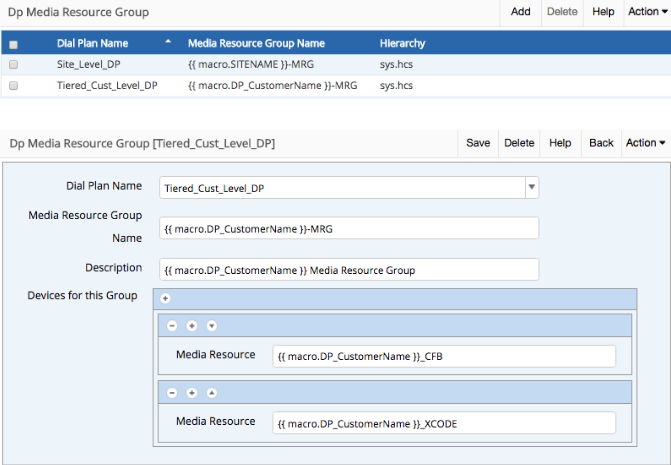
Media Resource Group fields:
- Dial Plan Name: Drop-down driven unique name given to the entire dial plan as a whole. This name appears in every dial plan model type.
- Media Resource Group Name: Free text field to enter a unique name for the Media Resource Group.
- Description: Meaningful description of the Media Resource Group.
- Devices for this Group: Array of member media resources for the Media Resource Group. In this instance using macros to enter the two customer level Transcoder and Conference Bridge instances.
Media Resource Group List Model¶
The Media Resource Group List dial plan model allows the administrator to define an unlimited number of Media Resource Group Lists.
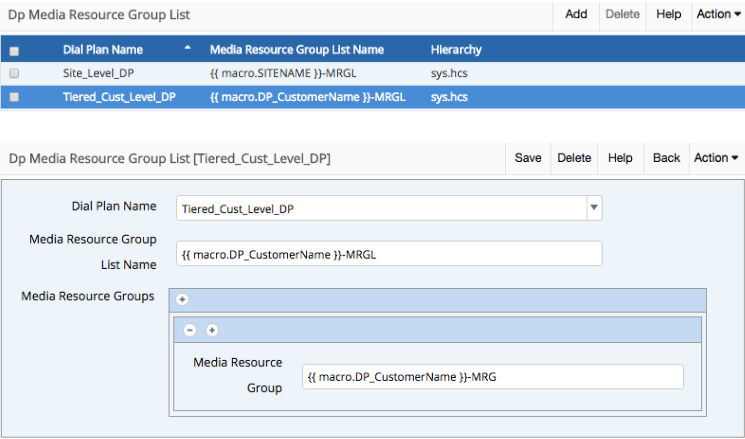
Media Resource Group List fields:
- Dial Plan Name: Drop-down driven unique name given to the entire dial plan as a whole. This name appears in every dial plan model type.
- Media Resource Group List Name: Free text field to enter a unique name for the Media Resource Group List
- Media Resource Groups: Array of media resource groups to assign to the Media Resource Group List. In this example binding the customer level MRG.
Route List Model¶
The Route List dial plan model allows the administrator to define an unlimited number of Route Lists.
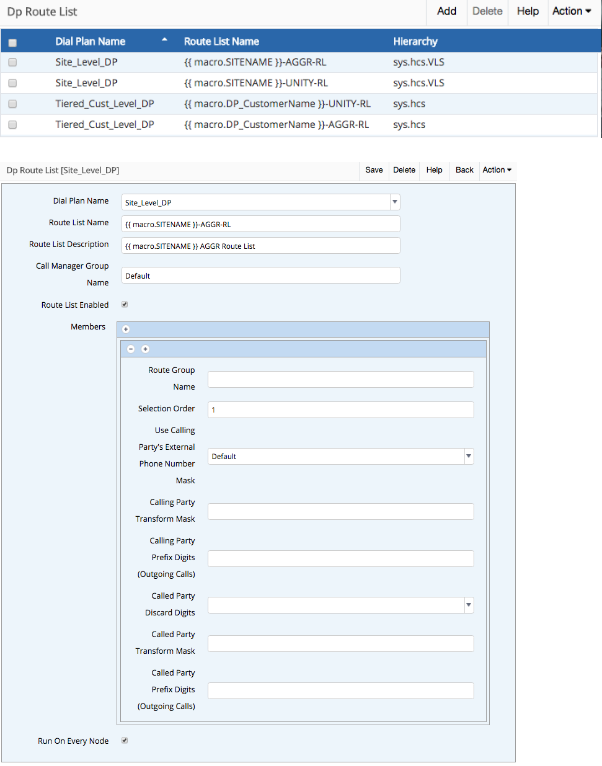
Route List fields:
Dial Plan Name: Drop-down driven unique name given to the entire dial plan as a whole. This name appears in every dial plan model type.
Route List Name: Free text field to enter a unique name for the Route List
Route List Description: Meaningful description of the Route List.
- Call Manager Group Name: Free text field to designate the proper Call Manager
Group
Route list Enabled: Check box to set the Route List Enabled field in Call Manager.
Members: Array to enter member elements to the route list.
- Route Groups Name: Free text field to assign a route group to the Route List.
- Selection Order: The order in which the Route Groups will be placed in the Route List.
- Use Calling Party’s External Phone Number Mask: Drop-down providing Call Manager
available options:
- Default
- On
- Off
- Calling Party Transform Mask: Free text field to enter common Call Manager Transform Mask data.
- Calling Party Prefix Digits (Outgoing Calls): Free text field to enter common Call Manager Calling Party Prefix Digit data.
- Called Party Discard Digits: Drop-down providing Call Manager available options:
- None
- PreDot
- PreDot Trailing-#
Note that more discard instructions may be added at market demand.
- Called Party Transform Mask: Free text field to enter common Call Manager Transform Mask data.
- Called Party Prefix Digits (Outgoing Calls): Free text field to enter common Call Manager Called Party Prefix Digit data
Route Group Model¶
The Route Group dial plan model allows the administrator to define an unlimited number of Route Groups.

Route Group fields:
- Dial Plan Name: Drop-down driven unique name given to the entire dial plan as a whole. This name appears in every dial plan model type.
- Route Group Name: Free text field to enter a unique name for the Route Group
- Distribution Algorithm: Drop-down providing the Call Manager options:
- Top Down
- Circular
- Longest Idle Time
- Broadcast
- Route Group Devices: Array to add devices to the route group. In this example a primary and secondary SIP trunk to aggregation.
SIP Trunk Model¶
The SIP Trunk dial plan model allows the administrator to define an unlimited number of SIP Trunks.
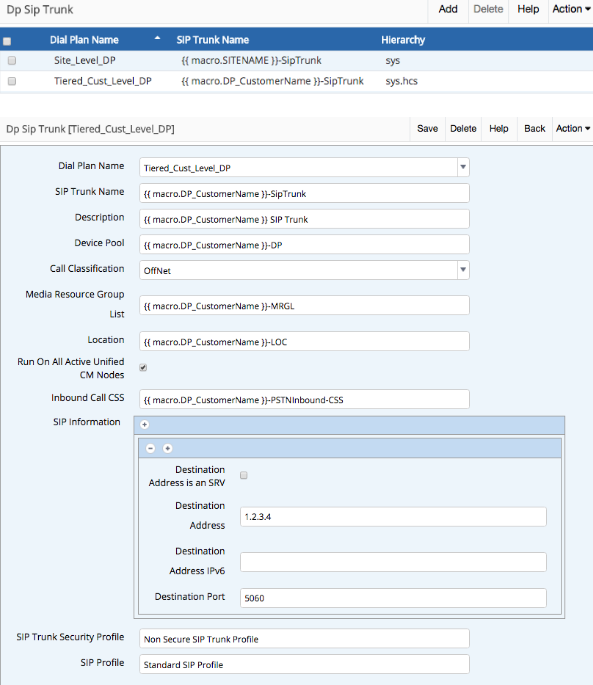
SIP Trunk fields:
- Dial Plan Name: Drop-down driven unique name given to the entire dial plan as a whole. This name appears in every dial plan model type.
- SIP Trunk Name: Free text field to enter a unique name for the SIP Trunk
- Description: Meaningful description of the SIP Trunk.
- Device Pool: Free text field to enter the proper device pool for the trunk
- Call Classification: Drop-down providing Call Manager options:
- Offnet
- OnNet
- Use System Default
- Media Resource Group List: Free text field to enter the proper MRGL for the SIP Trunk.
- Location: Free text field to enter the proper Location for the SIP Trunk.
- Run On All Active CM Nodes: Check box to set the run on all nodes option.
- Inbound Call CSS: Free text field to enter the proper CSS for SIP Trunks per dial plan.
- SIP Information: Array to add multiple SIP IP Destination:
- Destination Address: The IPv4 IP address of the destination.
- Destination Address IPv6: The IPv6 of the destination.
- Destination Port: The TCP/IP port for the SIP Trunk instance.
- SIP Trunk Security Profile: Free text field to enter a valid SIP Trunk Security Profile.
- SIP Profile: Free text field to enter a valid SIP Profile.
Partition Model¶
The Partition dial plan model allows the administrator to define an unlimited number of Partitions.
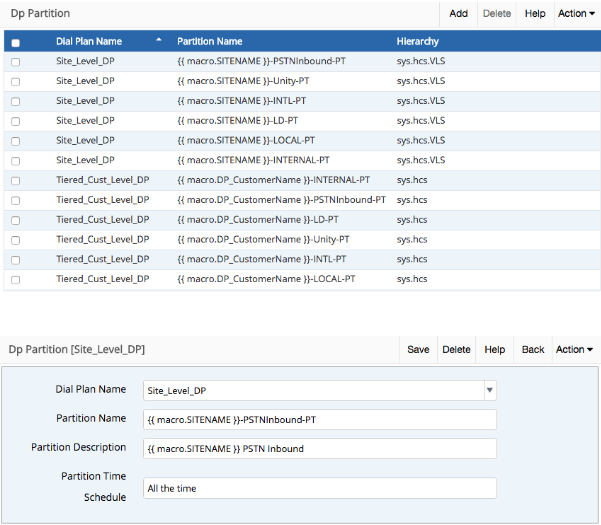
Partition fields:
- Dial Plan Name: Drop-down driven unique name given to the entire dial plan as a whole. This name appears in every dial plan model type.
- Partition Name: Free text field to enter a unique name for the Partition.
- Partition Description: Meaningful description of the Partition.
- Partition Time Schedule: Time schedule for the Partition if required per dial plan. May be left blank.
Calling Search Space Model¶
The Calling Search Space (CSS) dial plan model allows the administrator to define an unlimited number of CSS.
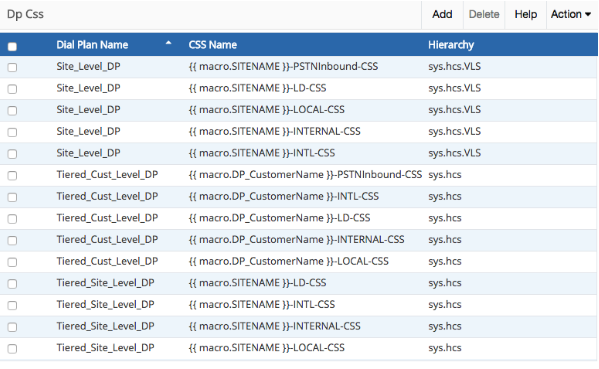

CSS fields:
- Dial Plan Name: Drop-down driven unique name given to the entire dial plan as a whole. This name appears in every dial plan model type.
- CSS Name: Free text field to enter a unique name for the CSS.
- CSS Description: Meaningful description of the CSS.
- Partitions: Array to add Partitions associated in order to the CSS.
- Route Partition Name: Free text field to enter valid Partition name
- Partition Index: Free text field to enter the numeric id for Partition order.
Route Pattern Model¶
The Route Pattern dial plan model allows the administrator to define an unlimited number of Route Patterns. “Local Dialing” flag will be covered in a following section.
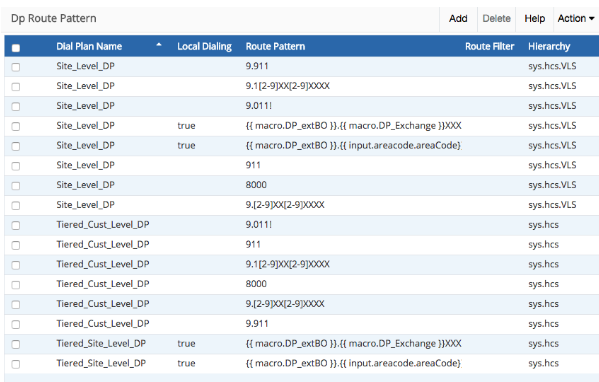
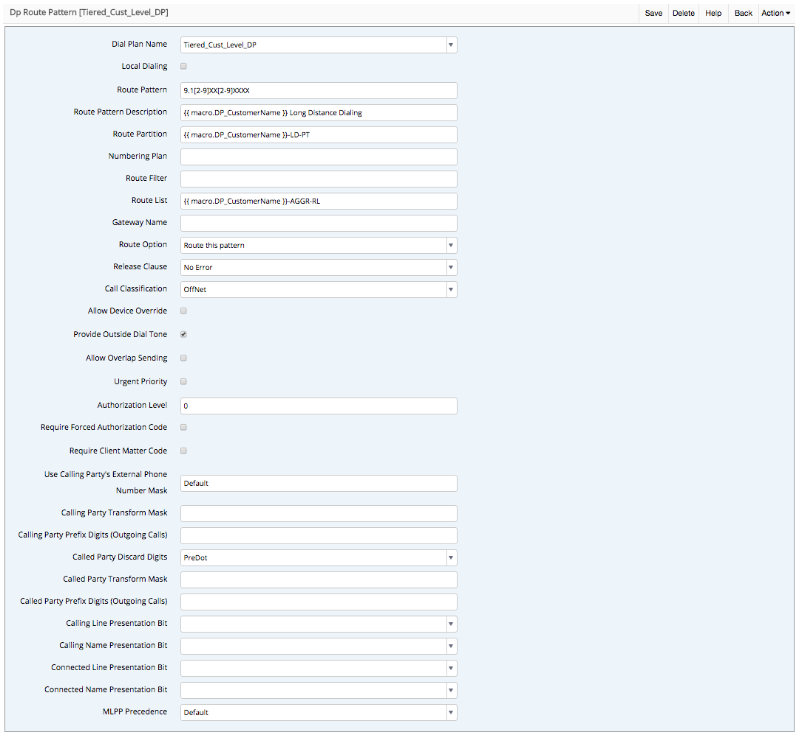
Route Pattern fields:
- Dial Plan Name: Drop-down driven unique name given to the entire dial plan as a whole. This name appears in every dial plan model type.
- Local Dialing: Check box to identify special patterns.
- Route Pattern: Free text field to enter a common Call Manager routing pattern.
- Route Pattern Description: Meaningful description of the Route Pattern.
- Route Partition: Free text field to enter a valid CUCM Partition.
- Numbering Plan: Free text field to enter a valid CUCM Numbering Plan if IDP is utilized.
- Route Filter: Free text field to enter a valid route filter name.
- Route List: Free text field to enter a valid route list name.
- Gateway Name: Free text field to enter a valid gateway name.
- Route Option: Drop-down providing Call Manager option:
- Route this pattern
- Block this pattern
- Release Clause: Drop-down providing Call Manager option:
- No Error
- Unallocated Number
- Call Rejected
- Number Changed
- Invalid Number Format
- Precedence Level Exceeded
- Call Classification: Drop-down providing Call Manager option:
- Offnet
- OnNet
- Allow Device Override: Check box to enable device override.
- Provide Outside Dial Tone: Check box to enable Outside Dial Tone.
- Allow Overlap Sending: Check box to enable Overlap Sending.
- Urgent Priority: Check box to enable Urgent Priority.
- Authorization Level: Free text box to enter Authorization Level as numeric value.
- Require Forced Authorization Code: Check box to enable Forced Authorization Code.
- Require Client Matter Code: Check box to enable Client Matter Code.
- Use Calling Party’s External Phone Number Mask: Drop-down providing Call
Manager available options:
- Default
- On
- Off
- Calling Party Transform Mask: Free text field to enter common Call Manager Transform Mask data.
- Calling Party Prefix Digits (Outgoing Calls): Free text field to enter common Call Manager Calling Party Prefix Digit data.
- Called Party Discard Digits: Drop-down providing Call Manager available options:
- None
- PreDot
- PreDot Trailing-#
Note that more discard instructions may be added at market demand.
- Called Party Transform Mask: Free text field to enter common Call Manager Transform Mask data.
- Called Party Prefix Digits (Outgoing Calls): Free text field to enter common Call Manager Called Party Prefix Digit data.
- Calling Line Presentation Bit: Drop-down providing Call Manager available
options:
- Default
- Allowed
- Restricted
- Calling Name Presentation Bit: Drop-down providing Call Manager available
options:
- Default
- Allowed
- Restricted
- Connected Line Presentation Bit: Drop-down providing Call Manager available
options:
- Default
- Allowed
- Restricted
- Connected Name Presentation Bit: Drop-down providing Call Manager available
options:
- Default
- Allowed
- Restricted
- MLPP Precedence: Drop-down providing Call Manager available options:
- Default
- Executive Override
- Flash
- Flash Override
- Immediate
- Priority
- Routine
Translation Pattern Model¶
The Translation Pattern dial plan model allows the administrator to define an unlimited number of Translation Patterns. “Local Dialing” flag will be covered in the following section.
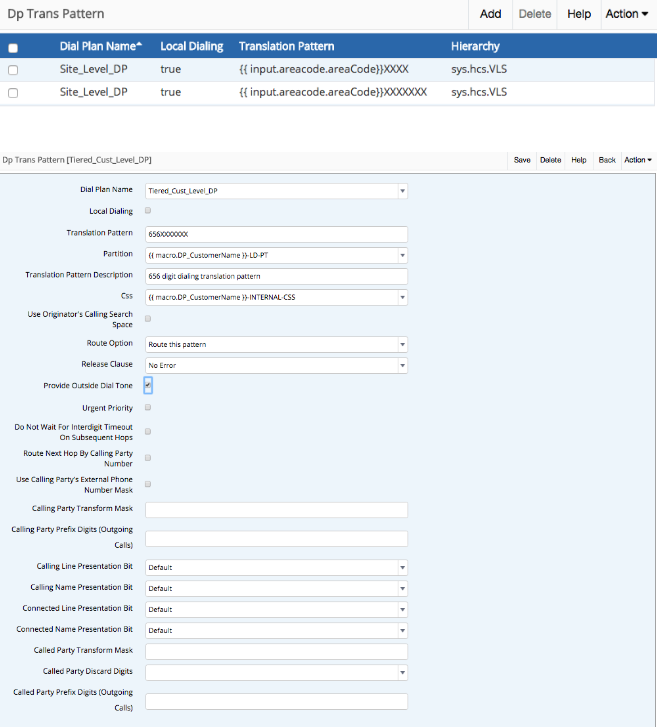
Translation Pattern fields:
- Dial Plan Name: Drop-down driven unique name given to the entire dial plan as a whole. This name appears in every dial plan model type.
- Local Dialing: Check box to identify special patterns.
- Translation Pattern: Free text field to enter a common Call Manager translation pattern.
- Partition: Free text field to enter a valid partition for the Translation Pattern.
- Translation Pattern Description: Meaningful description of the Translation Pattern.
- Css: Free text field to assign a valid CSS per the dial plan.
- Route Option: Drop-down providing Call Manager options:
- Route this pattern
- Block this pattern
- Release Clause: Drop-down providing Call Manager options:
- No Error
- Unallocated Number
- Call Rejected
- Number Changed
- Invalid Number Format
- Precedence Level Exceeded
- Provide Outside Dial Tone: Check box to enable Outside Dial Tone.
- Urgent Priority: Check box to enable Urgent Priority.
- Do Not Wait For Interdigit Timeout On Subsequent Hops: Check box to bypass interdigit timeout.
- Route Next Hop By Calling Party Number: Check box to enable Route Next Hop By Calling Party Number.
- Use Calling Party’s External Phone Number Mask: Check box to enable use of Calling Party’s External Phone Number Mask.
- Use Originator’s Calling Search Space: Check box to enable Originator’s Calling Search Space.
- Calling Party Transform Mask: Free text field to enter common Call Manager Transform Mask data.
- Calling Party Prefix Digits (Outgoing Calls): Free text field to enter common Call Manager Calling Party Prefix Digit data.
- Calling Line Presentation Bit: Drop-down providing Call Manager available
options:
- Default
- Allowed
- Restricted
- Calling Name Presentation Bit: Drop-down providing Call Manager available options:
- Default
- Allowed
- Restricted
- Connected Line Presentation Bit: Drop-down providing Call Manager available options:
- Default
- Allowed
- Restricted
- Connected Name Presentation Bit: Drop-down providing Call Manager available options:
- Default
- Allowed
- Restricted
- Called Party Transform Mask: Free text field to enter common Call Manager Transform Mask data.
- Called Party Prefix Digits (Outgoing Calls): Free text field to enter common Call Manager Called Party Prefix Digit data.
Route Pattern and Translation Pattern ‘Local’¶
The Translation/Route Pattern local designation in dial plan model allows the administrator to define patterns as local or looping patterns from the Site/Customer dial plan input sheet. The dial plan input sheets allow for creating a list of local area code/exchange that can be referenced via macro values to create site or customer level unique patterns.
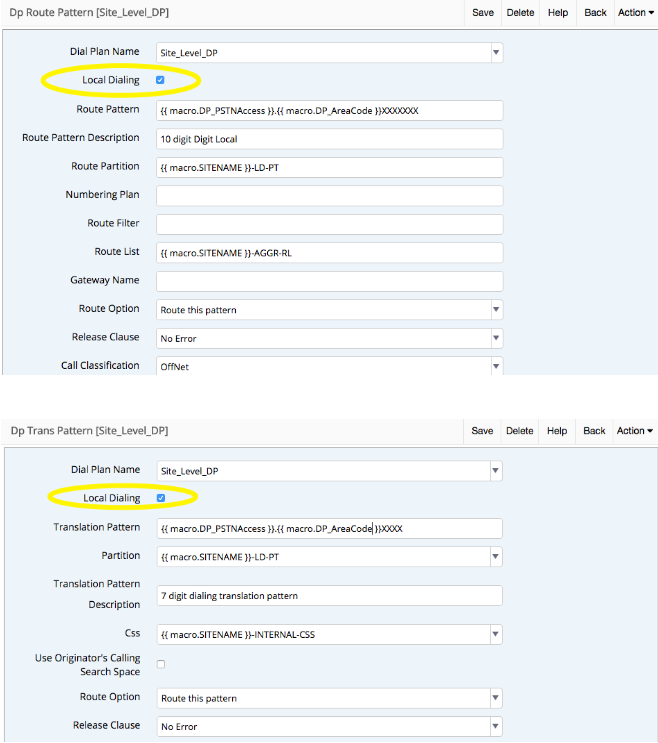
CTI Route Points¶
The CTI Route Point dial plan model allows the administrator to define an unlimited number of CTI Route points with an associated line.
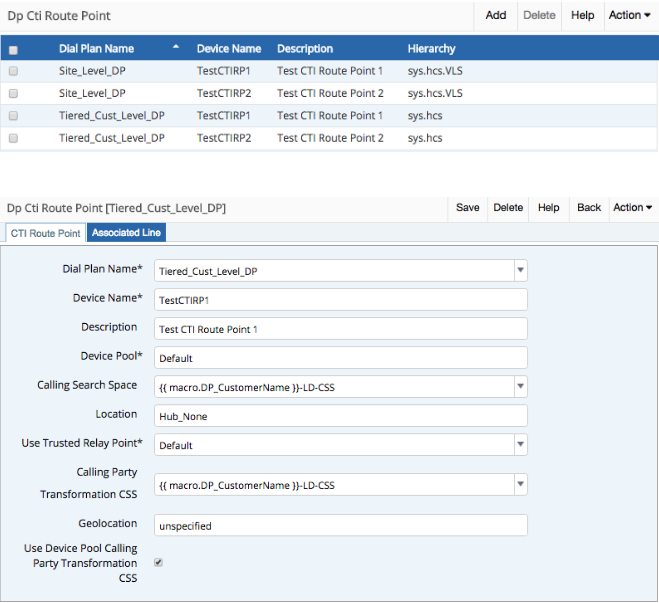
CTI Route Point Device fields:
- Dial Plan Name: Drop-down driven unique name given to the entire dial plan as a whole. This name appears in every dial plan model type.
- Device Name: The unique device name assigned to the CTI Route Point.
- Description: Meaningful description of the CTI Route Point.
- Device Pool: Free text field to enter the proper device pool for the CTI Route Point.
- Css: Drop-down field that provides a list of CSS from the dial plan css model.
- Location: Free text field to assign a valid Call Manager Location
- Use Trusted Relay Point: Drop-down with values:
- Default
- Off
- On
- Calling Party Transformation CSS: Drop-down field that provides a list of CSS from the dial plan css model.
- Geolocation: Free text field to enter a geolocation if necessary.
- Use Device Pool Calling Party Transformation CSS: Check box to enable Use Device Pool Calling Party Transformation CSS.

CTI Route Point Line Fields:
- CTI Route Point DN: The back end system will take the input from this field and create the Internal Number Inventory entry marked as used, then create a CUCM Line with the input number then finally associate the newly created line to the CTI Route Point.
- CTI Route Point Line Description: Meaningful description of the CTI Route Point Line.
- CTI Route Point Line Partition: Drop-down field that provides a list of Partitions from the dial plan partitions model.
- CTI Route Point Line CSS: Drop-down field that provides a list of CSS from the dial plan css model.
Called Party Transformation Model¶
The Called Party Transformation dial plan model allows the administrator to define an unlimited number of Called Party Transformations.

Called Party Transformation fields:
- Dial Plan Name: Drop-down driven unique name given to the entire dial plan as a whole. This name appears in every dial plan model type.
- Pattern: Free text field to allow entry in standard Call Manager patterns.
- Description: Meaningful description of the Called Party Transformation.
- Route Partition: Free text field for entry of a valid Call Manager Partition.
- Called Party Discard Digits: Drop-down providing Call Manager available options:
- PreDot
- PreDot Trailing-#
Note that more discard instructions may be added at market demand.
- Called Party Transformation Mask: Free text field for entry of transformation mask.
- Called Party Prefix Digits: Free text field for entry of prefix digits.
- Called Party Number Type: Drop-down providing Call Manager options:
- Cisco CallManager
- Unknown
- National
- International
- Subscriber
- Called Party Numbering Plan: Drop-down providing Call Manager options:
- Cisco CallManager
- ISDN
- National Standard
- Private
- Unknown
Calling Party Transformation Model¶
The Calling Party Transformation dial plan model allows the administrator to define an unlimited number of Calling Party Transformations.
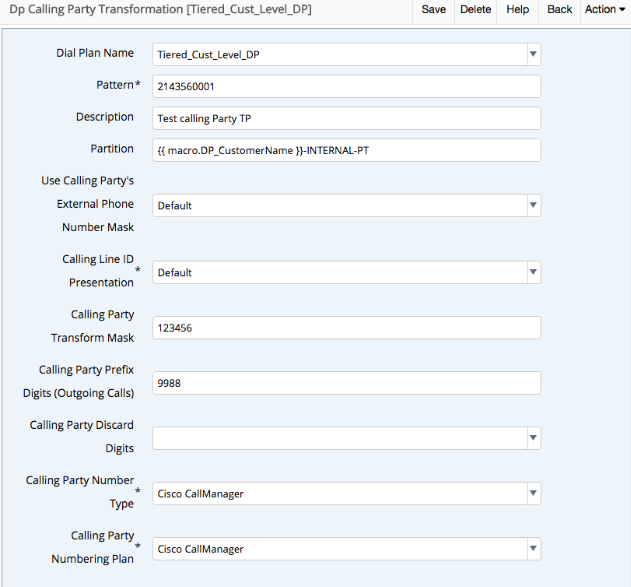
Calling Party Transformation fields:
- Dial Plan Name: Drop-down driven unique name given to the entire dial plan as a whole. This name appears in every dial plan model type.
- Pattern: Free text field to allow entry of standard Call Manager patterns.
- Description: Meaningful description of the Called Party Transformation.
- Partition: Free text field for entry of a valid Call Manager Partition.
- Use Calling Party’s External Phone Number Mask: Drop-down providing Call
Manager available options:
- Default
- On
- Off
- Calling Line ID Presentation: Drop-down providing Call Manager available
options:
- Default
- Allowed
- Restricted
- Calling Party Transform Mask: Free text field to enter common Call Manager Transform Mask data
- Calling Party Prefix Digits (Outgoing Calls): Free text field to enter common Call Manager Calling Party Prefix Digit data.
- Called Party Discard Digits: Drop-down providing Call Manager available options:
- PreDot
Note that more discard instructions may be added at market demand.
- Called Party Number Type: Drop-down providing Call Manager options:
- Cisco CallManager
- Unknown
- National
- International
- Subscriber
- Called Party Numbering Plan: Drop-down providing Call Manager options:
- Cisco CallManager
- ISDN
- National Standard
- Private
- Unknown
SIP Route Pattern Model¶
The SIP Route Pattern dial plan model allows the administrator to define an unlimited number of SIP Route Patterns.
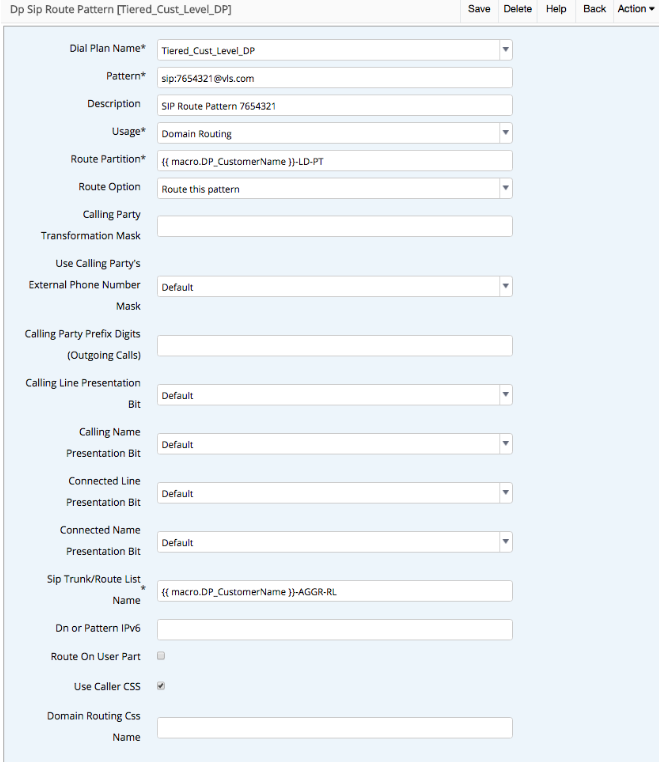
SIP Route Pattern fields:
- Dial Plan Name: Drop-down driven unique name given to the entire dial plan as a whole. This name appears in every dial plan model type.
- Pattern: Free text field to allow entry in standard Call Manager patterns uri patterns.
- Description: Meaningful description of the SIP Route Pattern.
- Usage: Drop-own providing Call Manager options:
- Domain Routing
- Route Partition: Free text field for entry of a valid Call Manager Partition.
- Route Option: Drop-down providing Call Manager options:
- Route this pattern
- Block this pattern
- Calling Party Transform Mask: Free text field to enter common Call Manager Transform Mask data
- Use Calling Party’s External Phone Number Mask: Drop-down providing Call
Manager available options:
- Default
- On
- Off
- Calling Party Prefix Digits (Outgoing Calls): Free text field to enter common Call Manager Calling Party Prefix Digit data.
- Calling Line ID Presentation: Drop-down providing Call Manager available options:
- Default
- Allowed
- Restricted
- Calling Name Presentation: Drop-down providing Call Manager available options:
- Default
- Allowed
- Restricted
- Calling Line Presentation Bit: Drop-down providing Call Manager available
options:
- Default
- Allowed
- Restricted
- Calling Name Presentation Bit: Drop-down providing Call Manager available
options:
- Default
- Allowed
- Restricted
- Connected Line Presentation Bit: Drop-down providing Call Manager available
options:
- Default
- Allowed
- Restricted
- Connected Name Presentation Bit: Drop-down providing Call Manager available
options:
- Default
- Allowed
- Restricted
- Sip Trunk/Route List Name: Free text field for entry of a valid SIP Trunk or Route List Name.
- Dn or Pattern IPv6: Free text field for entry of Dn or Pattern IPv6.
- Route On User Part: Check box to enable Route On User Part.
- Use Caller CSS: Checkk box to enable use of Caller CSS.
- Domain Routing Css Name: Free text field for entry of a domain routing CSS.
